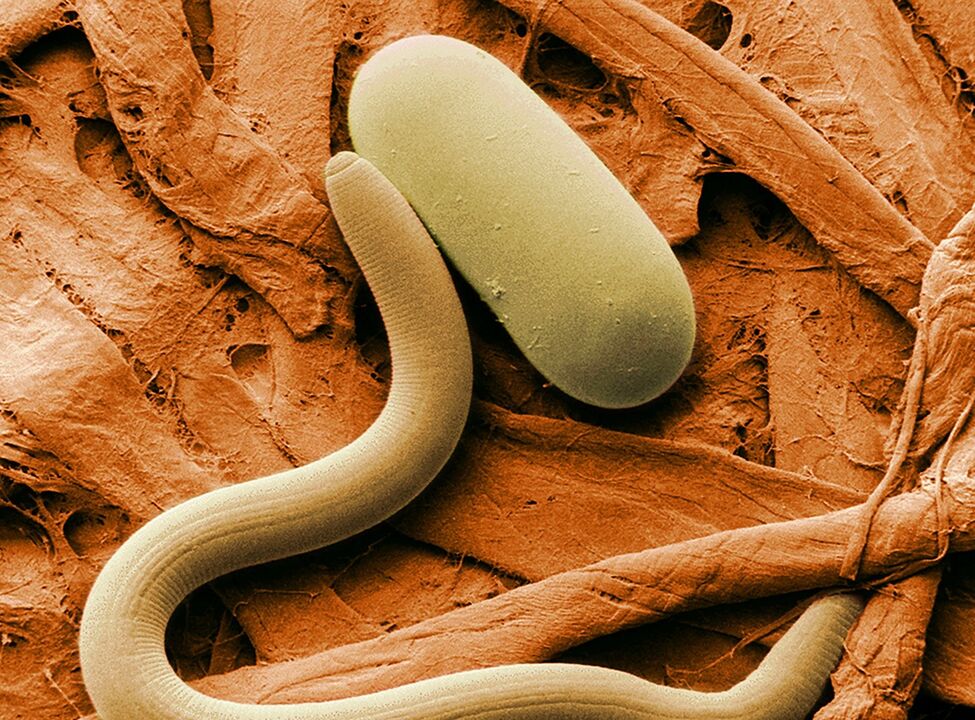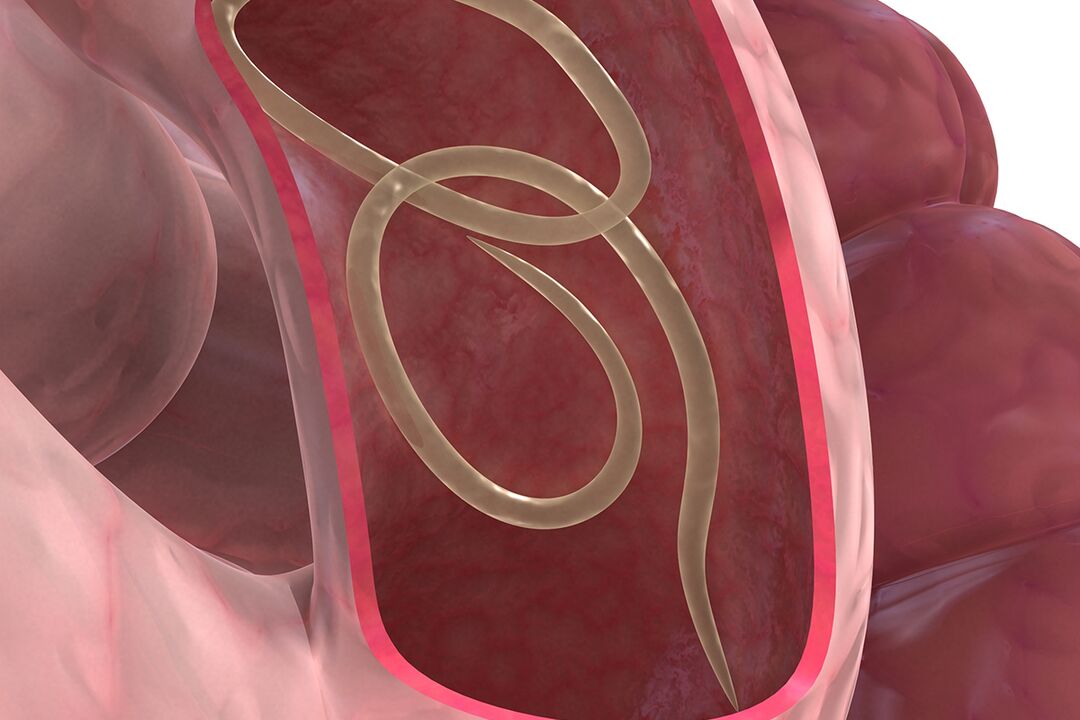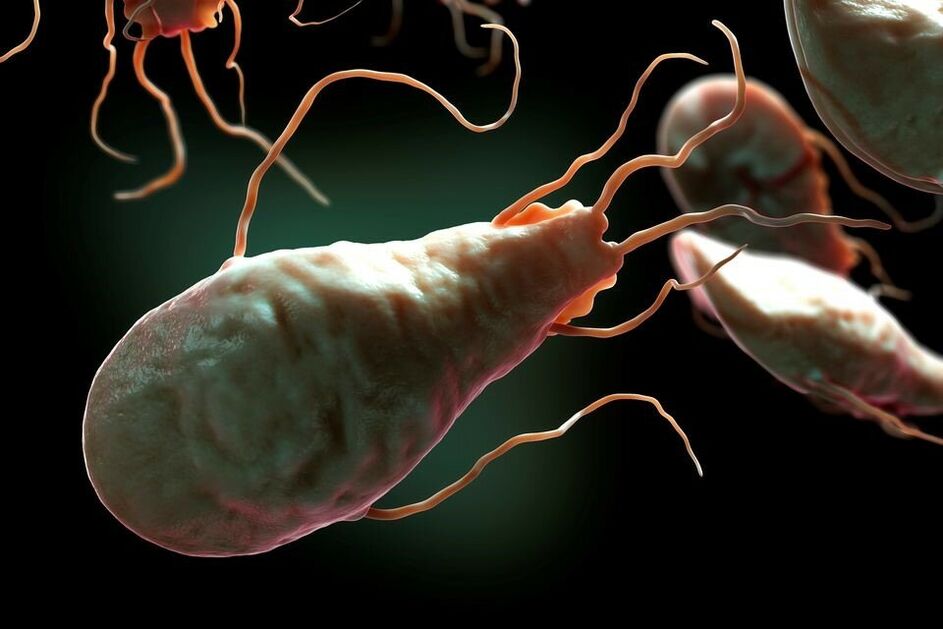Worms are representatives of the lower class of worms that live in the human body. The disease that involves a person being infected with many different types of worms is known as helminthiasis. This disease is not uncommon and occurs in certain sections of the population. Children are susceptible to pinworm infections, hunters - trichinella, fishermen and lovers of Japanese cuisine (raw fish in the form of sushi) get diphyllobothriasis. Paradoxically, many diseases can occur in the human body due to helminth infections. To date, the theory of the relationship between cancer and parasitic infections is one of the most relevant. With helminthiasis, symptoms are not always present, and if patients with this disease experience any discomfort and discomfort they are considered to be signs of other diseases. The patient had been treated for pancreatitis, gastritis or colitis for many years, not suspecting that the cause of his illness was a helminthic infection.
How does the infection happen?
Worms bring a lot of trouble to a person

Helminth infections occur as follows:
- Through unwashed hands
- When in contact with the ground
- After being bitten by an insect
- Because of dirty hands
- When eating raw meat and fish
- After eating unwashed fruits and vegetables
- After coming into contact with an animal
- After coming into contact with infected people
Mature eggs of the parasite can be found in soil, water, food (raw meat or fish and poorly processed by heat). Rarely, the disease occurs due to insect bites. The mechanism of infection with helminths is oral - fecal. A person swallows the eggs of the parasite with food or water. Household contact methods of infection also occur. They occur when, after contact with soil or sand, hands are not washed thoroughly.
Vegetables and fruits growing in the ground that are not washed are also a source of worm infection. Children playing with yards and pets are at risk of getting worms. Pets roaming the street can bring worm eggs into the home. Flies and other insects, after contact with animal feces, land on food, can easily transmit helminth eggs. Surprisingly, human-to-human transmission is also possible. It happens like this: female pinworms can come out of the intestines and lay eggs right on the underwear, causing intense itching. A person's hair is itchy after combing, which can come in contact with other sanitary and household items. These items fall into the hands of other family members, who then become infected.
Waterborne infection can also occur. Many parasitic eggs easily fall into open water bodies and wells. Drinking unboiled well water is extremely dangerous.
Types of worms
Helminthiases differ in the way they enter the human body:
- Biological worms
- Geohelminths
- contagious
Helminthiasis is transmitted to humans through contact with animals. Earthworms can be infected through the soil. Infection occurs through contact with an infected person. The disease has different manifestations depending on the mode of infection, the number of worms, the degree of adaptation in which human organ.
Stages of helminthiasis

The most devastating effects on the body are not caused by the adults, but by their larvae. The adults have chosen a cozy place for themselves in the human body, and the larvae move through the organs and leave wounds. The most common habitat of the parasite is the gastrointestinal tract. Different types of parasites prefer different habitats. Thus, roundworms reside in the small intestine, and pinworms settle in the large intestine and the lower parts of the small intestine. According to the habitat of the parasite, helminths are:
- diaphanous
- cloth
Translucent is located in the lumen of the genital organs and tissues - inside the tissues. Depending on development, the parasites can change their habitat, changing from translucent to tissue form. Heartworm disease develops in two stages:
- sharp
- Chronic
The acute phase lasts from a week to a month, and the chronic phase continues until healing. The acute phase begins with the birth of an egg and continues as the parasite matures and develops. The disease is manifested by allergic reactions to a foreign organism. In the chronic stage of the disease, various reactions of the body occur. During this stage, the parasites move around the body in search of shelter. This disease is accompanied by disturbances in the functioning of organs and systems in the human body. After integrating into the immune system of the human body, the parasites consume substances necessary for their growth and development. That leads to metabolic disorders, digestive system disorders, difficulty absorbing vitamins and minerals.
In addition to this harm, parasites spray their waste products into the human body, causing intoxication of the body, leading to intestinal disorders, reduced immunity and the development of bacterial infections. Parasites contribute to the risk of developing cancer. This happens due to a negative effect on the immune system, and stimulates the process of cell division. Often a patient is examined by many specialists who find a lot of diseases in the body. And in this case, only one doctor, a parasitologist, can replace all specialists.
Classification of worms

roundworms are quite common
Types of worms in humans:
- flatworms
- roundworm
Flatworms include:
- Tapeworms (opisthorchis, schistosomes, paragonim)
- Cestodes (wide tapeworm, tapeworm, echinococcus, alveococcus)
- Roundworms or nematodes:
- Pinworm
- roundworm
- hookworms
- Trichinella
Such classification of helminths is presented in the medical literature. To successfully deal with a problem such as helminthiasis, it is necessary to find an in-depth description of the structure and life cycle of the parasite.
fluke disease
Another name for fluke is fluke. These parasites are flat, leaf-shaped or lanceolate with two ends. One straw is located in the mouth and the second one, which serves for attachment, is in the peritoneum. All representatives of the fluke enter the body through an intermediate host. These parasites are mainly hermaphrodites.
Opisthorchises
This fluke is a worm up to 1. 3 cm long with two tips. Opisthorchis is hermaphroditic, parasitic in the liver, gall bladder, pancreas in humans and in some carnivores (foxes, dogs, cats). The eggs of the small liver fluke leave the human or animal body along with the feces. When entering the tank, these eggs are swallowed by freshwater mollusks, inside which the larvae will hatch and develop. The development and maturation of the larvae takes two months. The larvae then emerge from the molluscs and penetrate under the skin to the carp. After six weeks, the larvae become fully adult parasites. Opisthorchis enters the body of animals or humans after eating infected fish. This worm can live in the body for up to 20 years. Symptoms of eye stones:
- Allergy
- Weak
- Headache
- Dizzy
- Depression
- Loss of consciousness
Harm of opisthorchiasis on the body:
- Poisoning by the waste products of parasites
- Liver tissue damage
- Gallbladder damage
- Violation of the flow of bile
- Pancreatitis
- Excretory dysfunction
- Decreased gastric motility
- Thickening of the walls of some organs, resulting in the appearance of tumors.
The chronic course of the disease is characterized by:
- Heaviness after eating
- Wound
- vomiting
- Nausea
Habitat of opisthorchis in rivers with a lot of fish:
- Kame
- Dnipro
- Neman River Delta
Infection prevention: To avoid opisthorchiasis infection, do not eat raw fish. Larvae die during product heat treatment. Dried fish can only be eaten if it has been salted before. In addition, larvae die when fish are frozen for long periods of time.
Schistosomes

These parasites have different sexes, they look like a needle from 0. 4 to 2. 6 cm long, females are longer than males and larger, they lay 3000 eggs per day. The mode of reproduction, as in previous parasitic species, is through freshwater mollusks. Larvae enter the human body through the skin and mucous membranes when swimming in freshwater reservoirs. It can also enter the body of a person who accidentally swallows water while swimming. After a day of penetration, the larva turns into an adult and enters the peripheral veins, through which it is directed to the lungs and venous vessels. There, the schistosomes reach sexual maturity.
Schistosoma lays eggs in the intestines, mucous membranes, bladder. The eggs are then excreted from the human body in urine or feces and begin a new development path. Schistosoma lives in the human body for several decades, damaging and infecting new individuals. The problems that arise during schistosome infection, the human body are more caused not by adults, but by their eggs. Only half of the eggs are eliminated from the body, the rest accumulates in the organs. The eggs of this parasite have spines that damage human internal organs, often appearing sores in infected people. Patients with schistosomiasis experience the following symptoms:
- Appetite disorder
- Anemia
- Big liver
- Spleen is changed
- Decreased intestinal motility
- Stomachache
- constipation
- diarrhea
- Weight loss
- Intestinal bleeding
- Pain while urinating
- allergy
- Weak
When the genitourinary system becomes infected, the patient experiences:
- Menstrual irregularities and miscarriage in women
- Impotence and incomplete ejaculation in men
When the egg enters the central nervous system:
- Acute brain-eating schistosomiasis
- Chronic brain damage
- Deadly end
Infected children have growth and development retardation, reduced academic performance in school. Disease prevention includes avoiding swimming and avoiding walking barefoot in tropical waters.
Paragonim

Paragonim is a lung fluke 1 cm long, ovoid body and red spines. This parasite multiplies in the lungs of animals and enters the human body when eating crayfish, freshwater crabs. The parasite is transmitted through the respiratory system. For patients with paragonimiasis, allergic reactions and decreased immunity are characteristic. Symptom:
- Increased temperature
- A cough
- Excretion of sputum from the lungs when coughing
- Shortness of breath
- In some severe cases, there is blood and parasite eggs in the sputum.
- In the patient's lungs, wheezing can be clearly heard.
- Prevention: exclude the use of live crayfish and crabs.
Cestodes
Representatives of the code are tapeworms of various lengths. Some parasites reach gigantic sizes. The heads of these parasites have suckers, hooks or suckers. These adaptations are necessary for the parasite to adhere to the intestinal wall. The worms affect the entire human body, they are most dangerous for children who quickly become anemic.
Echinococcus
These parasites are up to 5 cm in length and are the causative agents of Echinococcus. Multicompartmental representatives of this worm are pathogens such as pneumococcal disease. Diseases carried by livestock and livestock. When caring for these animals, the eggs of the parasites fall from their fur into the hands of people. Upon entering the human intestine, the parasite bites on the mucous membrane. As the parasite matures, 4 parts appear, the last part is stuffed with eggs. These parts are emitted and dispersed throughout the body, infecting it. The fourth part scatters eggs all over the body.
Infected organs in the patient are increased, for example the liver. Replenishment can form. An enlarged organ can even disrupt the abdominal cavity. And this can lead to serious sepsis of the body and even death. Symptom:
- Weak
- Dizzy
- Allergic reaction to the waste products of the parasite.
Echinococcus affects:
- Brain
- Spinal cord
- Look
- Thyroid
- Liver
- Lung
- uterus
This parasite can cause the formation of tumors, including malignant ones. The most annoying thing is that the treatment of this disease can only be surgery. Prevention: personal hygiene when in contact with animals.
Nematode
Worms with elongated, round or cylindrical bodies parasitize most often in children. These types of roundworms include pinworms, roundworms, and hookworms.
Pinworm

These are small white worms. The length of the female is 1 cm, the male is 0. 5 cm, these parasites have a pointed tail, which is why they are called pinworms. The habitat of the pinworm is the human intestinal tract. The anterior end of the parasite has a sucker, with the help of the pinworm, the pinworm pierces the intestines and the pointed end hangs down the lumen and damages the wall. This disease is called intestinal worm disease. You can get the infection from a person through dirty hands. There are diseases in preschool children going to kindergarten. One symptom of a pinworm infection is itching around the anus. Usually, itching is felt at night, when the female lays eggs, which at the same time secrete a special substance. Symptom:
- Itchy
- Diarrhea
- Stomachache
- Headache
- Anorexia
- Prevent
- Hand washing
Roundworm
These worms are the largest. The length of the female is up to 0. 5 m, the female lays 200 thousand eggs per year, regardless of the male. The mechanism of infection is the fecal-oral route. Roundworm eggs enter the human body along with unwashed fruits and vegetables through dirty hands. Intestinal larvae are selected from the shell and penetrate the intestinal wall, and migrate through the intestinal veins to the liver, through the hepatic veins to the heart, through the pulmonary arteries to the bronchi, and then into the bronchi. trachea and into the mouth. Part of the larvae die in the open air, the rest are swallowed back. Symptom:
- Nausea
- Vomit
- Jaundice
- pancreatitis
- Frequent acute respiratory infections
- Bronchitis
- Pneumonia
Prevent:
- Hand washing
- Wash vegetables and fruits
- Personal sanitary
- Protect food from flies, cockroaches and other peddlers.
In conclusion, it can be said that the cause of the disease is not always bacteria or viruses that have entered the body. Parasites can cause great harm to human health. In case the symptoms are not clear, do not exclude the entry of parasites into the body, the patient should see a parasitologist.





























